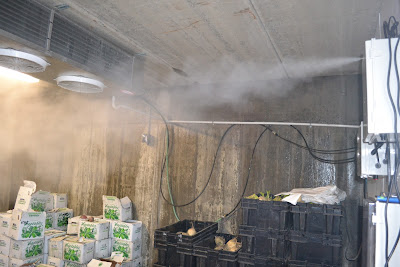The mission of Stone Barns Center is to create a healthy and sustainable food system that benefits us all. Located 25 miles north of Manhattan, Stone Barns Center for Food and Agriculture is a 501(c)3 nonprofit institution. We operate an 80-acre four-season farm and work to:
- Increase public awareness of healthy, seasonal and sustainable food.
- Train farmers in resilient, restorative farming techniques.
- Educate children about the sources of their food, and prepare them to steward the land that provides it.
The conference ran Thursday and Friday. Our marketing manager, Patti Lennon and our commercial sales rep for NY, Amber Flint also came out on Wednesday to attend the conference. The first day, I went to a few seminars, like this one Jack did on greenhouse management and like a nervous mother, kept adding finishing touches at the tunnel. I was also asked to do a filmed interview, presumably for the "Voices of the Young Farmers Conference" clip that Stone Barns usually posts on their website. Mine was to be a single-question interview: "What are the top 3-5 season extension methods for young farmers to know about?" That was also nerve wracking, but I got through it. :)
On the second day, Eliot Coleman and I had a roundtable discussion just after breakfast with anyone who wanted to attend (we got about 50-60 takers) around Innovations in Tools. Eliot had a 30 minute slide show where he presented some of the ideas he has had over the years, including some that Johnny's has brought to market. I then petitioned the audience for suggestions as to what products we could bring to market that would help them do their job? We got several suggestions, that were mostly related to projects we were already working on, which just confirmed our own suspicions of those projects' viability. Each time someone would suggest something, we'd start grinning at each other before they were finished. Too funny.
Eliot's daughter, Clara Coleman (Divide Creek Farm), also attended. It was great to finally meet her and have a chance to talk. She is one of the nicest people I have ever met.
Later that morning, I attended a presentation by Ben Shute, who is involved with the National Coalition of Young Farmers and Farm Hack.
Ben spoke a little about his organizations and had us break into groups to brainstorm ideas around specific aspects of farming to come up with ideas for ways to improve the way they are done. This was a fun exercise. He also spoke about the launch of a new Farm Hack website which will be complete with forum software to categorize participants ideas and serve as a central depository for them as well as a resource for the future. This, I think, is a tremendous idea and I am very excited about it.
In the afternoon, it was time for my Caterpillar Tunnel Workshop, which Amber was nice enough to help me with. A group of about 30 attendees followed me out to the North field, where I spoke first about low tunnels, then small hoophouses and caterpillar tunnels, and then on to moveable tunnels. We bent some pipes on the bender I had mounted on a picnic table and went over just about every square inch of the tunnel, talking about its construction and operation and how it differed from a fixed tunnel. People were invited to come inside and at the end, we removed the clamps, released the plastic, and moved the tunnel up and down the rails. There was a lot of participation by the group and they had many questions. Overall, I think it went very well.
Prior to the conference, Eliot and I had organized a meeting scheduled for the Saturday after YFC at Stone Barns with several industry professionals to do something similar to what Ben Shute had in mind - get together and brainstorm new tool innovations. Eliot had been working with Barry Griffin, a mechanical engineering professor from Harvard on a project they call "Slow Tools". Stone Barns has even agreed to fund one of their projects - a simple battery powered light cultivating tractor. Eliot's agenda for the meeting read like this:

On Saturday morning, we assembled at the Barns and started right in by introducing ourselves and suggesting two or three ideas of interest. We then began to talk about some of those ideas and eventually settled and spent a lot of time on the tractor project. Around noon, the Barns graciously set us up in a private dining room for lunch. We then got back together and stayed until after 5:00, talking about how to get these things done. One recurring them was the notion that often times ideas become public and then die right there. We all vowed to keep this thing going. To that end, Josh and Barry offered to set up a listserv to allow the group to stay on the same page and communicate efficiently.
 |
| First Inaugural Slow Tools Summit, 2011 |
I would like to thank the Stone Barns staff, particularly Fred Kirschenmann, Jill Eisenbarger, Erica Helms, Nena Johnson, Jack Algiere, Dan Barber, Zach Wolf and Josiah for their participation and cooperation in making the YFC and STS a success for us. Special thanks also to the Slow Tools Summit attendees that had to travel and make time in their busy schedules in order to make that a reality. I'm very excited about the direction this is all going and I am very much looking forward to our next meeting.
It was a long, groggy ride home on Sunday, but wow. What a week!
Here's the complete gallery:
Thanks!
Adam.
Adam Lemieux
Tools & Supplies Manager








































